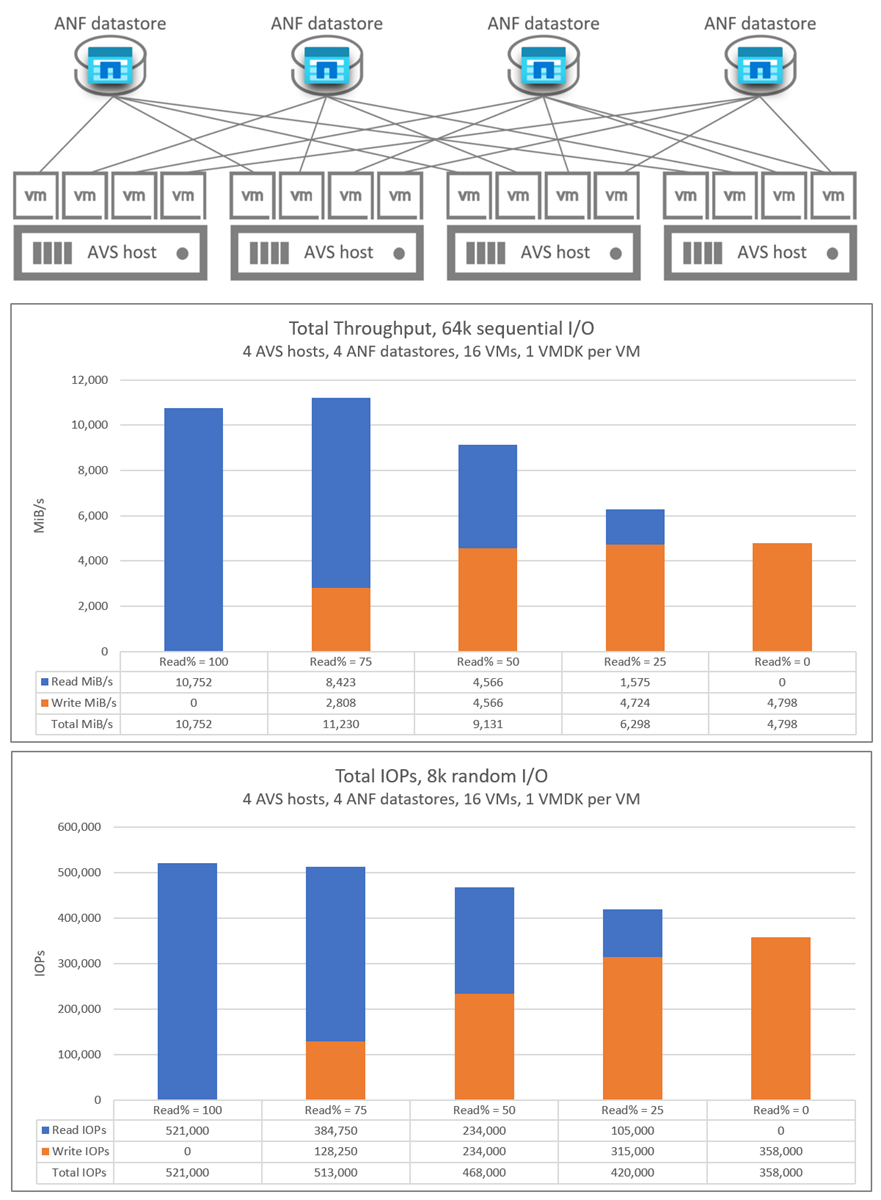Azure NetApp Files datastore performance benchmarks for Azure VMware Solution
This article describes performance benchmarks that Azure NetApp Files datastores deliver for virtual machines on Azure VMware Solution (AVS).
The tested scenarios are as follows:
- One-to-multiple virtual machines running on a single AVS host and a single Azure NetApp Files datastore
- One-to-multiple Azure NetApp Files datastores with a single AVS host
- Scale-out Azure NetApp Files datastores with multiple AVS hosts
The following read:write I/O ratios were tested for each scenario: 100:0, 75:25, 50:50, 25:75, 0:100
Benchmarks documented in this article were performed with sufficient volume throughput to prevent soft limits from affecting performance. Benchmarks can be achieved with Azure NetApp Files Premium and Ultra service levels, and in some cases with Standard service level. For more information on volume throughput, see Performance considerations for Azure NetApp Files.
Consult the Azure NetApp Files datastore for Azure VMware Solution TCO Estimator to understand the sizing and associated cost benefits of Azure NetApp Files datastores.
Latency
Traffic latency from AVS to Azure NetApp Files datastores varies from submillisecond (for environments under minimal load) up to 2-3 milliseconds (for environments under medium to heavy load). The latency is potentially higher for environments that attempt to push beyond the throughput limits of various components. Latency and throughput can vary depending on factors including I/O size, read/write ratios, competing network traffic, and others.
Performance scaling
Each AVS Host connects to each Azure NetApp Files datastore with a fixed number of network flows which can limit an individual VM disk's (VMDK) or AVS host’s throughput to each datastore. Multiple datastores might be required depending on a given set of workloads and their performance demands. Overall storage performance for each AVS host can be increased by spreading workloads across multiple datastores. You can also increase performance by spreading workload to each datastore across AVS hosts. The following graph shows the relative performance scaling of additional datastores.
Note
Throughput ceiling for external datastores can be limited by other factors including network bandwidth, SKU limits, or service level ceilings for Azure NetApp Files volumes.
Throughput for each individual host can be affected by the selected AVS SKU. The AV64 SKU has 100-Gigabit Ethernet (GbE) network interface cards (NICs). The other SKUs have 25-GbE NICs. Individual network flows (such as NFS mounts) might be limited by the 25-GbE NICs.
AV64 environment details
The results in this article were achieved using the following environment configuration:
- Azure VMware Solution host size: AV64 running VMware ESXi version 7u3
- Azure VMware Solution private cloud connectivity: UltraPerformance gateway with FastPath
- Guest virtual machines: Rocky Linux 9, 16 vCPU, 64 GB memory
- Workload generator:
fio3.35
Note
The AV64 tests focus only on the evaluation of a single ESXi host. Scaling out the number of ESXi hosts is discussed in the AV36 section.
One-to-multiple Azure NetApp Files datastores with a single AV64 host
The following graphs compare the throughput of a single virtual machine on a single Azure NetApp Files datastore with the aggregated throughput of eight VMs, each on their own Azure NetApp Files datastores. Similar throughput can be achieved by a smaller number of VMs with additional VMDKs spread across the same number of datastores.
This graph compares throughput:
This graph compares I/OPS:
AV36 environment details
These tests were conducted with an environment configuration using:
- Azure VMware Solution host size: AV36 running VMware ESXi version 7u3
- Azure VMware Solution private cloud connectivity: UltraPerformance gateway with FastPath
- Guest virtual machines: Ubuntu 21.04, 16 vCPU, 64-GB Memory
- Workload generator:
fio
One-to-multiple virtual machines running on a single AV36 host and a single Azure NetApp Files datastore
In a single AVS host scenario, the AVS to Azure NetApp Files datastore I/O occurs over a single network flow. These graphs compare the throughput and I/OPs of a single virtual machine with the aggregated throughput and I/OPS of four virtual machines. In the subsequent scenarios, the number of network flows increases as more hosts and datastores are added.
One-to-multiple Azure NetApp Files datastores with a single AV36 host
The following graphs compare the throughput of a single virtual machine on a single Azure NetApp Files datastore with the aggregated throughput of four Azure NetApp Files datastores. In both scenarios, each virtual machine has a VMDK on each Azure NetApp Files datastore.
The following graphs compare the I/OPS of a single virtual machine on a single Azure NetApp Files datastore with the aggregated I/OPS of eight Azure NetApp Files datastores. In both scenarios, each virtual machine has a VMDK on each Azure NetApp Files datastore.
Scale-out Azure NetApp Files datastores with multiple AV36 hosts
The following graph shows the aggregated throughput and I/OPS of 16 virtual machines distributed across four AVS hosts. There are four virtual machines per AVS host, each on a different Azure NetApp Files datastore. Nearly identical results were achieved with a single virtual machine on each host with four VMDKs per virtual machine and each of those VMDKs on a separate datastore.







